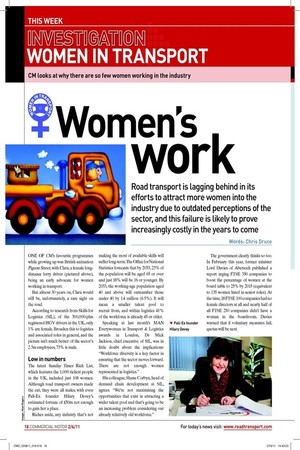omen’s
Page 16

If you've noticed an error in this article please click here to report it so we can fix it.
or
Road transport is lagging behind in its efforts to attract more women into the industry due to outdated perceptions of the sector, and this failure is likely to prove increasingly costly in the years to come
Words: Chris Druce
ONE OF CM’s favourite programmes while growing up was British animation Pigeon Street, with Clara, a female longdistance lorry driver (pictured above), being an early advocate for women working in transport.
But almost 30 years on, Clara would still be, unfortunately, a rare sight on the road.
According to research from Skills for Logistics (SfL), of the 300,000-plus registered HGV drivers in the UK, only 1% are female. Broaden this to logistics and associated roles in general, and the picture isn’t much better: of the sector’s 2.3m employees, 73% is male.
Low in numbers
The latest Sunday Times Rich List, which features the 1,000 richest people in the UK, included just 108 women. Although road transport owners made the cut, they were all males, with even Pall-Ex founder Hilary Devey’s estimated fortune of £50m not enough to gain her a place.
Riches aside, any industry that’s not making the most of available skills will suffer long-term. The Ofice for National Statistics forecasts that by 2033, 23% of the population will be aged 65 or over and just 18% will be 16 or younger. By 2033, the working-age population aged 40 and above will outnumber those under 40 by 1.4 million (6.5%). It will mean a smaller talent pool to recruit from, and within logistics 41% of the workforce is already 45 or older.
Speaking at last month’s MAN Everywoman in Transport & Logistics awards in London, Dr Mick Jackson, chief executive of SfL, was in little doubt about the implications: “Workforce diversity is a key factor in ensuring that the sector moves forward. There are not enough women represented in logistics.” His colleague, Shane Corbyn, head of demand chain development at SfL, agrees. “We’re not maximising the opportunities that exist in attracting a wider talent pool and that’s going to be an increasing problem considering our already relatively old workforce.” The government clearly thinks so too. In February this year, former minister Lord Davies of Abersoch published a report urging FTSE 350 companies to boost the percentage of women at the board table to 25% by 2015 (equivalent to 135 women hired in senior roles). At the time, 18 FTSE 100 companies had no female directors at all and nearly half of all FTSE 250 companies didn’t have a woman in the boardroom. Davies warned that if voluntary measures fail, quotas will be next.














































